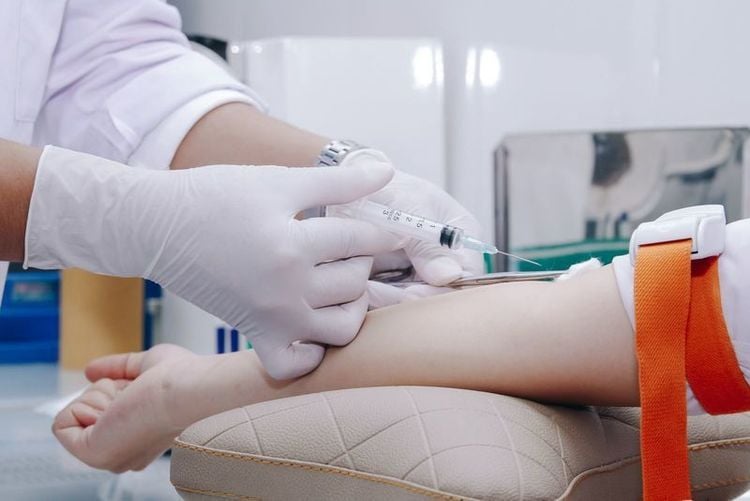This is an automatically translated article.
Cold Agglutinin test is done to check for health conditions. Certain infections, lymphoma, and pneumonia cause the body to make certain antibodies, called cold agglutinins.
1. Cold Agglutinin Test
1.1 What is the Cold Agglutinin Test? Cold agglutinin is an anti-erythrocytic antibody, normally produced by the immune system in response to an infection. Cold agglutinin causes red blood cells to clump together at a low temperature.
The cold agglutinin test is done to check for conditions that cause the body to make certain types of antibodies called cold agglutinin . In healthy people, there is usually a low concentration of cold agglutinin in the blood. However, certain infections such as mycoplasma pneumonia or lymphoma can cause cold agglutinin levels to rise.
Higher than normal cold agglutinin levels do not cause serious problems. Sometimes, high levels of cold agglutinin can cause blood to clot in blood vessels under the skin when the skin is exposed to cold. This causes pale skin and numbness in the hands and feet. Symptoms disappear as the skin warms up. In some cases, clotted blood cells can block blood flow to the tips of your fingers, toes, ears, or nose, causing frostbite and possibly tissue damage. In rare cases, it can cause gangrene. Sometimes high levels of cold agglutinin can destroy red blood cells throughout the body. This condition is called autoimmune hemolytic anemia.

Nồng độ agglutinin lạnh cao hơn mức bình thường khiến chân tay có cảm giác tê bì
1.2 Indications The cold agglutinin test may be done to:
See if high levels of cold agglutinin are causing autoimmune hemolytic anemia. Look for mycoplasma pneumonia. More than half of people with mycoplasma pneumonia have elevated blood levels of cold agglutinin within a week of infection. Newer tests for mycoplasma pneumonia have replaced the cold agglutinin blood test. 1.3 Performing the test The steps to performing a cold agglutinin blood test include:
Wrap an elastic band around your upper arm to stop the flow of blood. This makes the veins below the band larger, making it easier to insert the needle into the vein. Clean the needle site with alcohol. Place the needle into the vein. If the needle is not placed correctly or if the vein is collapsed, more than one needle may be needed. Hook a tube to the needle to fill it with blood. Remove the bandage from the arm when enough blood has been collected. Place a gauze pad or cotton ball over the needle site when the needle is removed. Apply pressure to the site of the blood draw and then bandage it.

Lấy máu tính mạch để thực hiện xét nghiệm agglutinin lạnh
1.4 Complications during the test Some problems can occur when doing a cold agglutinin blood test such as:
At the blood collection site, bruising may appear. To avoid bruising by keeping pressure on the site of blood collection for several minutes. In rare cases, a vein may become swollen after a blood sample is taken. This problem is called phlebitis. Warm compresses can be used several times a day for treatment.
2. Meaning of Cold Agglutinin Test
The cold agglutinin test is done to check for conditions that cause the body to make certain antibodies called cold agglutinin. Cold agglutinin test results are usually reported by titre.
2.1 Normal values The normal values listed here are called reference ranges. These ranges vary between laboratories. In addition, your doctor will evaluate the results based on your health and other factors. This means that a value outside of the normal values listed here may result in normal results. Normal titration: Less than 1 to 16 (1:16) at 4 degrees Celsius.

Kết quả xét nghiệm agglutinin lạnh thường được báo cáo bằng hiệu giá
2.2 High Value The high titre of cold agglutinin can be caused by infections, such as mycoplasma pneumonia, hepatitis C, mononucleosis, or other viral infections.
High levels of cold agglutinins can cause symptoms when a person is exposed to cold temperatures. These symptoms may include: numbness, burning, pain, or pale skin at the tips of your fingers, toes, ears, or nose. Very high titres may mean there is a higher risk of developing blood clots (thrombosis) when exposed to cold temperatures.
In addition, some agents can cause errors in test results such as taking antibiotics, especially penicillins and cephalosporins.
In a nutshell, the cold agglutinin test is done to check for conditions that cause the body to make certain antibodies such as infections, lymphoma,... Cold agglutinin test results are usually reported by antibody titer.
Vinmec International General Hospital is one of the hospitals that not only ensures professional quality with a team of leading medical doctors, modern equipment and technology, but also stands out for its examination and consultation services. comprehensive and professional medical consultation and treatment; civilized, polite, safe and sterile medical examination and treatment space.
Please dial HOTLINE for more information or register for an appointment HERE. Download MyVinmec app to make appointments faster and to manage your bookings easily.
See more:
Tests being performed at the anatomical laboratory of Vinmec Central Park hospital What is a cold biopsy (instant biopsy)? Summary of serodiagnostic methods - Part 1 Summary of serodiagnostic methods - Part 2













